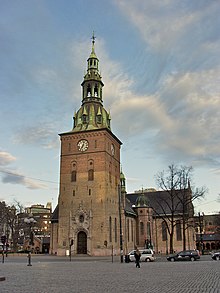Oslo Cathedral

The Evangelical Lutheran Oslo Cathedral ( Norwegian : Oslo Domkirke) is the largest church in Oslo . Until 1950 the cathedral was named Vår Frelsers kirke (Church of the Redeemer).
history
The cathedral is the third cathedral building in Oslo. A first cathedral ( Hallvards domkirke ) was built by King Sigurd I in the first half of the 12th century. After the great fire of Oslo in 1624, the city was relocated. A new cathedral was built in the new city center between 1632 and 1639, while the old one fell into disrepair. The new church burned down at the end of the 17th century. Today's cathedral was built in its place between 1694 and 1697.
In 1848/1850 the cathedral was rebuilt according to plans by the German architect Alexis de Chateauneuf (1799-1853) under the supervision of the German architect Heinrich Ernst Schirmer (1814-1887). When Chateauneuf fell ill in 1850, Schirmer commissioned Wilhelm von Hanno (1826–1882) to finish the construction.
On August 29, 1968, the Crown Prince and later King Harald V married Sonja Haraldsen here . On August 25, 2001, the wedding of her son Crown Prince Haakon of Norway with Mette-Marit Tjessem Høiby also took place in this church.
From August 2006 to April 2010 the cathedral was closed for renovation work for three years. On April 18, 2010 the church was reopened with a service.
Furnishing
The pulpit , the altar panel and the organ facade with acanthus carvings are still original. The stained glass is by Emanuel Vigeland , Gustav Vigeland's brother . The artist Hugo Lous Mohr designed ceiling paintings in Oslo Cathedral. The bronze doors were designed by the sculptor and painter Dagfin Werenskiold .
Altar: Jesus' Last Supper and crucifixion group
organ
The cathedral's large organ was rebuilt in 1997–1998 by the Norwegian organ builder Ryde & Berg behind the historic prospect by Lambert Daniel Kastens (1726–1729). It is the fifth instrument; the first instrument was built in 1702, further instruments followed in 1729, 1888 and 1930 ( EF Walcker , 102 rows of pipes; the Walcker organ was replaced by the new one in 1998). The new instrument has 53 registers (over 4,000 pipes) on three manuals and a pedal . The game actions are mechanical, the stop actions are electrical (setter system).
|
|
|
|
||||||||||||||||||||||||||||||||||||||||||||||||||||||||||||||||||||||||||||||||||||||||||||||||||||||||||||||||||||||||||||||||||||||||||||||||||||||||||||||||||||||||||
-
Pairing :
- Normal coupling: II / I, III / I, III / II, I / P, II / P
- Super octave coupling: III / P
See also
- List of Bishops in the Church of Norway
- Ole Christian Kvarme , Bishop of Oslo 2005–2017
- Norwegian Church
Web links
- Official website of Oslo Cathedral (Norwegian)
Individual evidence
- ↑ Alexis de Chateauneuf (Store norske leksikon)
- ↑ Wilhelm Von Hanno (Store norske leksikon)
- ↑ Oslo Pass Travel Guide, 2013, p. 42.
- ↑ More information on the history of the organs ( Memento from July 24, 2011 in the Internet Archive ) (archive)
- ↑ To the disposition ( Memento of March 7, 2016 in the Internet Archive )
Coordinates: 59 ° 54 ′ 44 ″ N , 10 ° 44 ′ 49 ″ E








